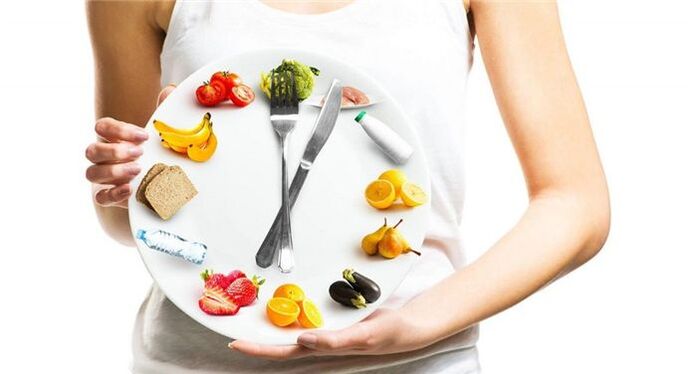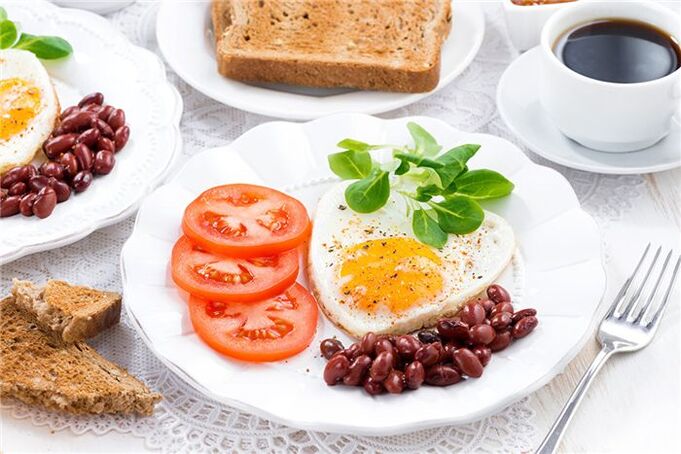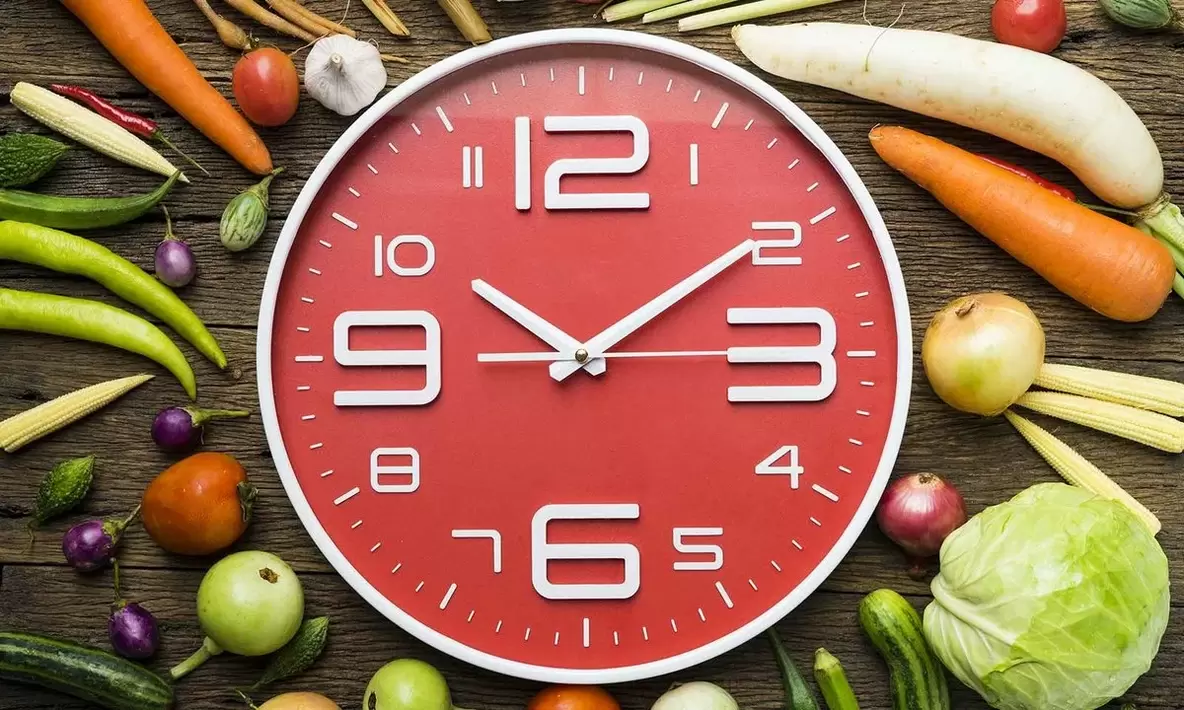
A diet for weight loss may be considered differently according to the proper nutrition system (PN). You can criticize and find fault with it, or you can enjoy your appearance and fanatically cling to it for the rest of your life. But it is a fact that the RP system is effective and has helped thousands of fat people who have given up, proven over time and confirmed by nutritionists.
Healthy eating is not just coleslaw and steamed fish. Millions of recipes for breakfast, lunch and dinner have been created according to the PP system, many of which satisfy the body's needs and deserve to be included in everyone's healthy diet plan!
PP program
- Pay attention to the "food pyramid", according to which 40% of the food on your table should contain complex carbohydrates (this is all types of bread, except cereals, cereals), 35% are fresh and steamed. or cooked vegetables and fruits, and 20% healthy proteins (lean meat, all types of poultry and fish, sour milk and dairy products). The remaining 5% can be derived from fats and sugars.
- Combine meat with vegetables.
- If you really want, you can eat something sweet. But do not exceed the permissible limit of sugar-containing products per day - 5 teaspoons. Better yet, replace the sugar with honey. All desserts can be consumed only in the first half of the day to burn the calories taken before the evening.
- Make sure your body is getting enough protein (a person needs at least 100-150g per day). Protein is a building block that regenerates cells and maintains muscle function. If you refuse meat and poultry, you should consume vegetable proteins, which are abundant in beans, nuts and soy.
- Avoid processed foods, fast food and sauces, as well as canned foods. A lot of sugar and salt are added to ketchup.
Deadline
Each diet can only be used for a limited period of time. After achieving the results, it is necessary to switch to a healthy diet. If you start to follow a healthy diet, you don't have to completely give up your favorite and unhealthy foods. But you need to strictly control the time and amount of consumption of such foods, as well as compensate for their caloric content with physical activities.
A healthy diet is very useful and beneficial, so you have to follow it throughout your life in the name of a slim figure and a healthy appearance.
It's time to create a menu for yourself!
What kind of nutrition can be called right?
Proper nutrition (sometimes called healthy) involves eating natural foods that only benefit the body. According to this principle, the diet of a person who plans to eat should have foods that contain the necessary amount of nutrients. We are talking about the following components:
It is necessary to enumerate them to ensure daily consumption. It is also important to follow other rules that make eating healthy. So fast food, processed food, carbonated drinks and other unhealthy foods should not be included in your diet. It is also recommended to limit the amount of salt, remove fried foods, steam or boil, boil, or bake foods. Food should be eaten at the same time every day.
How to create a menu for the week
The peculiarity of proper nutrition is that it does not mean sticking to a strict menu. It should be created taking into account the characteristics of a person and his food preferences. The main thing is to follow the basic principles of combining products. We are talking about the following rules:
- breakfast should be rich in carbohydrates;
- dinner should be high in carbohydrates;
- Each meal should contain fiber-containing products (vegetables, fruits, bran);
- if you want to eat sweets, it should be done only in the first half of the day;
- Proper distribution of calories is important.
As a rule, people who follow a healthy diet create a menu in advance for a week and then prepare meals according to it. Below is an example of a diet where the necessary nutrients have already been selected. Of course, changes can be made if, for example, a person does not eat a certain type of food.
How to create a meal plan for weight loss
Individually planning your menu for the day, week, and month will help you develop proper and well-defined eating habits. Fractional - at least 3 times, and 5-6 times a day - diet is the key to food order. You don't need to disrupt or rearrange your normal routine. Plan based on your lifestyle.
Eating patterns for "early risers" (for example, those who wake up at 6 am and go to bed at 10 pm)
- Have breakfast at 7: 00 am
- 10. 00, second light breakfast
- At 13. 00 for lunch
- 16. 00 afternoon tea
- Dinner at 19. 00
Diet regime of "night owls" (people who get up after 9: 00 a. m. and go to bed at 00: 00 a. m. )
- Eat at 10: 00 AM
- Lunch at 13: 00
- At 15: 00 it's time for lunch
- Go to afternoon tea at 17: 00
- 20. 00 it's time for dinner
So, adjust your eating routine to your daily routine.
Key recommendations
- Breakfast should be taken one hour after getting up
- Drink 250 ml of warm water in the morning on an empty stomach.
- There should be 2-3 hours between any meal
- dinner before bedtime or no later than two hours
To properly lose weight, you need to count the calories in all the foods you eat. For that, take a notebook or a special application on your phone and write down the amount of water or juice you drink.
What is important when creating a menu
- When planning your weekly menu, prepare a grocery shopping list right away. And immediately decide what to cook on which day. On some days, for example, chicken and fish should be added. One day you should have a light vegetable salad for dinner and a meaty steak for lunch.
- Don't skip breakfast even if you don't feel hungry. Each breakfast should be balanced and nutritious - 50% of daily carbohydrates should be reserved for breakfast, 30% for proteins, 20% for fats.
- Dinner should mainly contain proteins. For example, low-fat cottage cheese, baked chicken or steamed fish.
- Afternoon snacks and second breakfasts are proper and balanced snacks between main meals. But they should not become a complete meal. For meals, prepare fresh fruits (one banana, 150-200 g of grapes, one large apple), fresh or boiled vegetables (cabbage, tomatoes, carrots, radishes, etc. ), dried fruits or nuts without salt and not in bulk)must be).
- When calculating calories, it is necessary to exclude those burned during physical activity. For example, if you plan to ride around the city all day or have a long cyclocross planned, increase your diet for that day. Plan for adequate amounts of carbohydrates and proteins and have a good breakfast before leaving home.
- Drink plain drinking water - not chilled or boiled water (it cleans the intestinal tract and starts metabolic processes). Green tea is useful for those who are losing weight (it accelerates metabolism, replenishes the body's need for antioxidants and perfectly suppresses appetite).
- You can drink coffee, but only drink high-calorie variations (latte or cappuccino) before lunch.
Mistakes in losing weight
- Violation of sweet and starchy foods (they should not be completely rejected, but take a dose so as not to violate the norm of daily consumption).
- Fried and smoked. Food can be thermally processed if you fry it over an open fire without oil and smoke it naturally (not with artificial smoke) for no more than 20 minutes.
- Opt for raw vegetables and fruits over cooked and baked foods, and make the most of all types of vegetables.
- A heavy dinner with large portions. Boil or bake meat or fish, be sure to add fresh vegetables (for example, one fresh cucumber and 200 g of cooked beef).
- Frequent drinking of alcohol. It should be avoided because it is very high in calories and can cause a strong feeling of hunger.
- Do not drink water while eating. The same goes for tea or juice. Drink a glass of tea one hour before and half an hour after meals.
- Be careful with salt, spices and sauces. All of these are very appetite stimulating and can lead to binge eating and overeating.
- Do not eat. Always have a bag of nuts, water with lemon or a handful of raisins with you. In this way, you will curb your appetite and avoid overeating during delayed meals.
Sample menu for the week
First day
Breakfast: 200 g of rice, 10 g of butter, one banana or one apple, black coffee.
Snack: dried gray bread, boiled eggs, tomatoes.
Daily meal: steamed mackerel 200 g, Chinese cabbage salad with peas and sunflower oil 180 g.
Second snack: low-fat cottage cheese, 120 g spoon of 10% cream, green apple, 200 ml of tea.
Dinner: boiled vegetables 220 g, boiled beef 140 g
The second day
Breakfast: a sandwich made of a slice of bread, cream cheese and plastic cucumber, 100 g of grapes, tea or coffee with honey.
Perekus: cottage cheese 50 g with a teaspoon of honey.
Daily meal: 200 g of meat broth, fresh Chinese cabbage salad with cucumbers and tomatoes seasoned with lemon juice.
Second snack: red apple and kiwi, green or herbal tea.
Dinner: lean beef 200 g, two fresh cucumbers.
The third day
Breakfast: boiled oatmeal without milk - 210 g, a spoonful of honey, avocado and coffee without sugar.
Perekus: pine nuts or walnuts 60 g, green apple, tea, lemon slice.
Daily meal: 150 g of brown rice, the same amount of steamed vegetables.
Second snack: cottage cheese, semolina, 150 g of banana, herbal tea.
Dinner: 200 g of cleaned seafood, two cucumbers and one tomato.
The fourth day
Breakfast: oatmeal with milk 200 g, fresh blueberries, black berries or strawberries - 100 g.
Perekus: 100 g low-fat unsweetened yogurt, a teaspoon of honey and freshly brewed black coffee.
Daily meal: 250 g of cooked low-fat fish, 130 g of sauerkraut.
Second snack: tomato salad, cucumber, seasoned low-fat sour cream 200 g.
Dinner: 200 g of cooked chicken without skin, 30 g of parmesan, two cucumbers.
The fifth day
Breakfast: 200 g of mashed potatoes in water with 30 g of butter, one boiled egg, one cucumber.
Snack: green tea and two kiwis.
Daily meal: 260 g of barley and mushroom soup, dried bread or crackers and 10 g of cheese.
Second snack: homemade casserole made of cottage cheese, raisins and yogurt 150 g.
Dinner: 200 g of boiled hake and 100 g of seaweed.
The sixth day
Breakfast: scrambled omelet made of two eggs and 150 ml of milk, freshly brewed black coffee.
Snack: grapefruit or pomelo.
Daily meal: boiled potatoes 150 g with champignons 100 g, boiled chicken 70 g.
Second snack: 200 ml of kefir or low-fat yogurt, one green apple.
Dinner: low-fat cottage cheese 150 g sugar-free, two apples baked in the oven.
The seventh day
Breakfast: 200 g of water millet porridge, 30 g of butter, a glass of black tea without sugar.
Second breakfast: kiwi and banana.
Daily meal: steamed vegetable pot + 20 g of cheese - 250 g, boiled chicken fillet - 100 g.
Second snack: boiled shrimp 200 g, carrot or tomato juice 200 ml.
Dinner: steamed fish cutlet 150 g, boiled white rice 100 g, one tomato.
How to start a healthy diet
The fast pace of life and the products often offered on store shelves and fast food chains, packed with advertising, convenient to use, but not useful and often harmful, make many people think about how to start. eat right and include this in your daily schedule.
In addition to knowing how to portion out and balance your menu most effectively, it's helpful to consider the psychological aspect and ensure you're taking the right approach to changing your eating habits. No matter what the goal of the diet is - to lose weight or to realize the desire to improve well-being - it is very important to form the right approach to the problem.
Therefore, you should not:
- expect to instantly improve your health, completely change your eating preferences and habits in an instant;
- Focus on several complex tasks at once;
- immediate rejection of all normal food;
- increase the harmonization of the diet to the end and subjugate the whole way of life to it;
- It is better to focus on thoughts about food and direct the energy of the mind in another useful and important direction.
Why should you eat healthy?
Maintaining a daily routine and diet, avoiding bad habits and adequate physical activity are the main conditions for keeping the body in optimal condition. Often these simple truths are not forgotten until health problems begin, depriving a person of the ability to enjoy the everyday pleasures of life.
For those who face a lack of energy and physical strength, excess weight, poor sleep, skin and hair deterioration or any other diseases caused by an improper lifestyle, as well as thinking about their prevention in advance and deciding to switch to a harmonious diet, it will be very important to implement it in practice without delay.
The foundation of a healthy lifestyle has been and will continue to be proper nutrition. Since these substances enter the body with food, they are the main source of energy and raw material for the tissues of our body.
A necessary starting point would be the competent preparation of the diet for the day.
Rules for choosing a diet per day

Creating a balanced menu is very simple. Deciding to improve your health and shape, you need to take care of the quality, quantity and timing of food intake. Food should be fresh, the diet varied and properly distributed throughout the day.
- It is better to eat more and in smaller portions (4-6, not three times).
- Do not eat solid food before going to bed.
- Add vegetables to every meal.
- Drink more plain still water.
- Reduce the amount of simple carbohydrates.
Your healthy eating decisions will be rewarded with improved health, overall well-being, weight loss, and improved immunity.
A healthy diet for the day should follow a pattern where the first meal is denser than the following meals.
For beginners, it's important to get an understanding of the substances and their ratios that each body needs to function properly. The key to a balanced menu is the right combination of proteins, fats and carbohydrates, as well as the presence of trace elements such as magnesium, calcium, potassium, various vitamins and iron.
Start your day with a delicious and healthy breakfast

The first thing that enters the body should be plain, not cold water (if the acidity of the stomach allows, with the addition of natural fresh lemon juice). It helps to revive the digestive system and prepare it for further work. It is also useful for rapid removal of waste from the body, weight loss and improvement of skin condition.
It is necessary to drink a glass of water correctly - thirty minutes before meals, slowly, with small sips.
Contrary to popular belief, a nutritionist's advice for breakfast is to cut sweets out of it. This is explained by the fact that when taking one portion of glucose, the body requires the next one a little later, the first sugar is processed by the digestive system.
How to choose a healthy lunch
According to nutritionists, eating in the middle of the day should be from 25 to 50% of the total energy value of the daily diet.
To make lunch as healthy as possible, keep in mind the following suggestions:
- the beginning of the meal is soup;
- drinking hot (other than cold) drinks;
- the interval between lunch and the previous meal should be at least 2-3 hours;
- It is helpful to balance a very healthy lunch with a light dinner.
Under no circumstances should you ignore a full lunch.
What is good for dinner?
A balanced diet with dinner contains minimal calories. Avoid eating carbohydrates. However, it should not be completely excluded from the diet - it causes serious disturbances in the functioning of the digestive system.
You can give preference to natural yogurts, cooked poultry dishes, cottage cheese casserole, seafood.
A good choice would be a protein omelette or a small portion of legumes - peas, lentils, chickpeas.
The key to success is a combination of nutrient-dense foods and low-calorie foods.
How many calories and minerals should the body get?
Calories needed by the body are calculated by formulas containing information on the following parameters of a certain person:
Particular attention should be paid to the current state of the body, professional stress, lifestyle and purpose, and the person who decides to eat right for himself. If it is due to the desire to lose weight, the normal indicators will decrease by 20%, and if it is aimed to gain muscle mass, it will increase by the same amount.
According to average standards, women consume 1000 to 2000 kcal per day, men - 2500 to 5000. But exact calculations should be done individually.
What foods should be avoided when creating a healthy diet?

Adapting the body to a new nutritional system takes time, like forming any habit. If you can't eliminate all junk food at once, then it should be done gradually, allowing one thing from the forbidden list once a week.
It helps to relieve stress and have fun. However, this weakening should be compensated by increasing the amount of vegetables and fruits and drinking clean water.
Here is a list to help you limit unhealthy foods in your diet:
- rich, yeast-based and additive-containing baked goods, bread and wheat bread (it is better to give preference to unleavened grain and rye);
- confectionery products;
- sausage products;
- mayonnaise and sauces based on it;
- canned meat and fish;
- smoked and salted meat dishes;
- egg yolk;
- foods high in animal fat;
- alcohol;
- fast food, semi-finished products;
- Carbonated drinks, especially those that contain sweeteners, dyes, and flavorings.
It is especially important to understand the importance of freshness of produce and prepared food. Even healthy foods can be harmful if not prepared properly. Always prefers boiled and baked rather than fried.
An example of the correct menu for the day
Everyone's preferences are individual. Moreover, it is difficult to create a menu correctly for a long time. However, once you're on the road to a healthy diet, you'll gradually learn many recipes and new foods and choose the one that works best for you.
An approximate daily diet can be as follows:
- breakfast should include boiled eggs with buckwheat porridge, natural cocoa as a drink, as well as fresh apples or oranges;
- for lunch - salted soup, steamed, boiled or baked chicken meat without adding fat, preferably fillet, a piece of rye or rye bread, green tea with honey or lemon;
- you can eat fresh fruit or cottage cheese with berries during the afternoon snack;
- Dinner will be some lean meat (uncooked) and vegetables.
You can turn to fruits and vegetables for a snack, and when you're really hungry, you can turn to nuts and seeds. We should not forget about the daily consumption of plain water (about 2 liters), which is necessary for health.
On weekends
Some people believe that the weekend allows them to deviate from the diet and eat unhealthy foods that are not on the diet on other days. This opinion is incorrect, because such an act can cancel all the benefits of the previous menu. Of course, you can sometimes get a small amount of something that is not very useful. You can eat heavy meals during the holidays, but not every weekend.
The menu for Saturday in a healthy diet can be as follows:
- Breakfast includes oatmeal and baked apples. You should use tea as a drink. It should be understood that sugar should not be added to tea. If you want to sweeten the drink, it is recommended to use honey.
- Second breakfast - yogurt and banana.
- Vegetable and chicken soup can be prepared for lunch. Experts recommend choosing fish as a second dish. Salad - vinaigrette. Drink - compote.
- You can eat yogurt for lunch and add nuts to it. You can opt for dried fruits instead.
- A great option for dinner is a ham and vegetable stew. Beverage - tea.
Treat yourself to a cottage cheese casserole for Sunday breakfast. It should be seasoned with honey. Toast can be eaten with tea. For the second breakfast, you can choose yogurt and crackers. Lunch consists of borscht, buckwheat and chicken cutlets, compote. An excellent option for an afternoon snack, as usual, is cottage cheese with the addition of dried fruits. Boiled veal and vegetable salad are recommended for dinner.
What to do if you don't have enough time to cook

Consistency is the key to success for anyone who wants to eat healthy. Only long-term lifestyle changes can bring real benefits. Often, the modern pace of life of a working person does not leave much time. Do not, under any circumstances, give up on your decision to be healthy or your desire to lose weight.
The beginning of the journey is always the most difficult, we often give up on achieving what we want without even starting due to the limitation of time and energy resources, but there are professionals ready and willing to provide competent assistance.
If you don't have time to take care of your food, you can order ready, fresh and well-balanced meals for delivery. It is very easy to choose food for yourself from the section that matches your goal (lose weight, get fit after a diet, gain muscle mass, etc. ). A menu is offered for the calendar and working week with a detailed description of the composition of products and their useful substances.
At your request, we deliver healthy, fresh meals to eat at work or at home. Convenient service conditions allow you to enjoy a variety of healthy meals without wasting time and effort in the kitchen, many of which you cannot prepare yourself.
The ability to use services offered by respected and competent professionals eliminates the need to study a lot of videos, see photos and read articles to expand the culinary range.
There is no reason to put off a healthy eating plan. Do it today.














































































